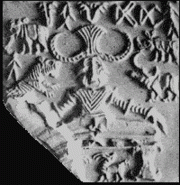Aryan Invasion Theory: the myth cant die?
There is yet another discussion going on at another blog – Shunya – on the so-called Aryan-Invasion Theory. It is interesting the way Namit, the author of the post characteristizes different protagonists in the discussion. Subhash Kak (head of Computer Science at Oklahoma State Univ) is introduced as a “revisionist” and Witzel, who wrote some controversial papers on this theory is introduced as a person who has written “brilliant papers”.
That introduction itself set me off to begin with. The discussion is as partisan thereafter as the intro was. There is a lady who is certainly un-educated in the Vedas – tries to discuss how “Siva, Ram and Krishna” never originated in the Vedas. Hmm, as far as I know Shiva (Rudra), Brahma (Prajapati) and Vishnu are mentioned in the Vedas so I found it very facetious in the way this entire discussion is usually handled. For example on Shiva:
A god named Rudra is mentioned in the Rig Veda. The name Rudra is still used as a name for Shiva. In RV 2.33 he is described as the “Father of the Maruts”, a group of storm gods. Furthermore, the Rudram, one of the most sacred hymns of Hinduism found both in the Rig and the Yajur Vedas, and
addressed to Rudra, invokes him as Shiva in several instances.
A seal was also found in Mohenjo daro of Pashupati, which some believe was a “prototype” of Shiva.
A seal discovered during the excavation of Mohenjo-daro has drawn attention as a possible representation of a “proto-Shiva” figure. This “Pashupati” (Lord of Animals,or Lord of Beings Sanskrit paśupati) seal shows a seated figure, possibly ithyphallic, surrounded by animals. Sir John Marshall and others have claimed that this figure is a prototype of Shiva, and have described the figure as having three faces, seated in a “yoga posture” with the knees out and feet joined.
Now, having said that, in my view, these similarities and differences are not as direct a proof as the DNA evidence should be. And that is where the rub comes. If the “Aryan” and “Dravidian” were indeed two different races originating in different places and fighting for land, then their DNA make-up should be radically different! If the Dravidians came from India and Aryans came decidedly from Europe, then there shouldn’t be much similarities. After all there are differences between the Western Europeans and Eastern Europeans which is very clear. But the DNA lineage gives up completely different clues!
Alternatively, the high frequency of R1a1 found in several South Indian tribes including the Chenchu and the Badagas, together with a higher R1a1-associated STR diversity in India and Iran compared with Europe and Central Asia, has been taken as evidence for an origin of R1a1 (M17) in Southern or Western Asia (Kivisild 2003b). Stephen Oppenheimer believes that it is highly suggestive that India is the origin of the Eurasian mtDNA haplogroups which he calls the “Eurasian Eves”. According to Oppenheimer it is highly probable that nearly all human maternal lineages in Europe (and similarly in East Asia) descended from only four mtDNA lines that originated in South Asia 50,000-10,000 years ago.
Studies like the one attached (Kivisild 2003) show that the genetic make up between tribal groups in South India and other parts of India (including North) is persistent. Also, as the Aryan Invasion theory insists that Dravidians who lived in North were driven by the Aryans to South during this invasion is also not supported by research (one of the largest on Indian DNA):
While considerable cultural impact on social hierarchy and language in south Asia is attributable to the arrival of nomadic Central Asian pastoralists, genetic data (mitochondrial and Y chromosomal) have yielded dramatically conflicting inferences on the genetic origins of tribes and castes of south Asia. We sought to resolve this conflict using high-resolution data on 69 informative Y-chromosome binary markers and 10 microsatellite markers from a large set of geographically, socially and linguistically representative ethnic groups of south Asia. We have found that the influence of Central Asia on the pre-existing gene pool was minor. The ages of accumulated microsatellite variation in the majority of Indian haplogroups exceed 10-15 kya, attesting to the antiquity of regional differentiation. Therefore, our data do not support models that invoke a pronounced recent genetic input from central Asia to explain the observed genetic variation in south Asia. R1a1 and R2 haplogroups indicate demographic complexity that is inconsistent with a recent single history. Associated microsatellite analyses of the high frequency R1a1 haplogroup chromosomes indicate independent recent histories of the Indus valley and the peninsular Indian region. Our data are also more consistent with a peninsular origin of Dravidian speakers than a source with proximity to the Indus and significant genetic input resulting from demic diffusion associated with agriculture. Our results underscore the importance of marker ascertainment towards distinguishing phylogenetic terminal branches from basal nodes when attributing ancestral composition and temporality to either indigenous or exogenous sources. Our reappraisal indicates that pre-Holocene and Holocene era (that’s before 10,000 BC) – not Indo-European – expansions have shaped the distinctive south Asian Y-chromosome landscape.
Technorati : AIT, Aryan Invasion Theory
Attachment: Genetic Heritage in India.pdf




